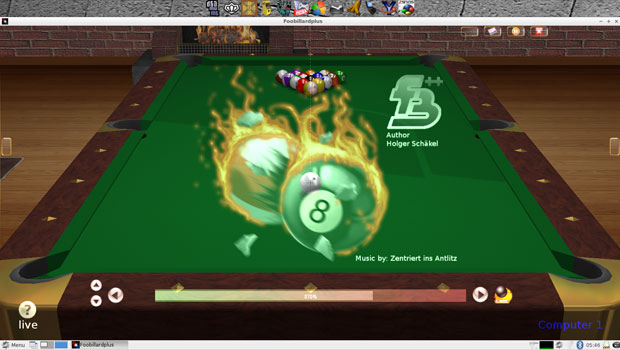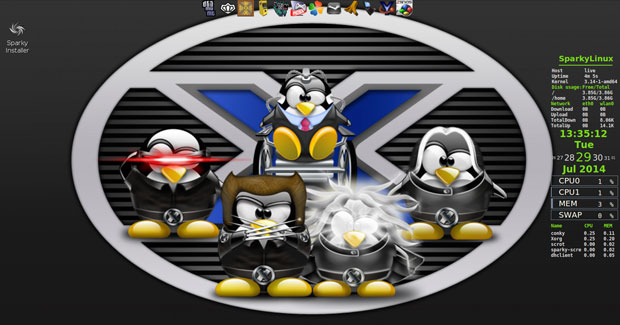![]()
The SparkyLinux GameOver 3.4 Edition may be one of the best Linux distros catering to game players you will find. It is a full-service specialty Linux OS with a focus on gaming.Linux distro developers usually do one of two things about games. One, they provide none or only a few low-impact card and puzzle titles. Two, they build in links to the PlayOnLinux and Steam websites.
Historically, few Linux distros have catered to serious game playing. The few that did are mostly now discontinued or inactive. One exception is Zorin 8 Gaming, which comes with a modest inventory of higher-end Linux games.
Still, topnotch access to leading desktop games is rarely something that Linux provides. That is what makes SparkyLinux GameOver so extraordinary.
This SparkyLinux game edition builds in access to a large collection of popular games compiled for the Linux platform. It brings the latest game fare via the Steam and Desura platforms. It provides handy access from a quick launch bar to a dozen plus emulators to let you run top-line games from leading gaming boxes and platforms.
GameOver does not wimp out on providing all of the needed everyday computing tools found in other Linux distros, either. It provides nearly all of the standard Linux applications out-of-the-box, so you do not have to install them on your own.
Under the Hood
The SparkyLinux family is built on the GNU/Linux Debian Testing release (Debian Jessie 8.0) and is available in 32-bit and 64-bit options that support i486 and x86 machines. It is designed for both old and new computers.
The GameOver Edition, released on July 17, is based on the SparkyLinux 3.4 Annagerman release of late June. The game version includes gaming optimizations and gaming applications in the default repositories that are absent in the regular versions.
GameOver runs on the LXLE desktop. Well suited for a gaming distribution, it is a lightweight, fast and simple environment.

The Annagerman versions offer desktop options in MATE 1.8; XFCE 4.10; Base — which is OpenBox 3.5.2-6; Razor-Qt; and a Command Line Interface (CLI) version. The regular edition also has an Enlightenment desktop version.
Games Galore
GameOver earns a high score with Linux gamers. They get the best of both worlds. Unlike using a branded game console, users can do real work on the same Linux distro they turn on for playing their favorite games. I am not talking about a link to PlayOnLinux or Steam or specialty game packages installed as third-party add-ons.
This distro provides four essential access points to game inventories. This access is integrated into a well-oiled Linux desktop machine.
For example, SparkyLinux GameOver Edition brings access to games compiled for the Linux platform. It adds access to games available from the Steam and Desura platforms. It also has preconfigured access to games created for the Microsoft Windows platform Wine, and PlayOnLinux. It even provides access to classic games created for discontinued machines and systems via emulators.

Emulator Envy
Having one or two game system emulators is nice. GameOver is much more than nice. It gives Linux users a one-stop work and play computing platform. It includes nearly every game emulator created.
These emulators are not lost within a deep menu list. Rather, the emulators launch from their own LX Panel separate from the main system panel at the bottom of the screen. By default, the game emulator panel is at the top of the screen. Access the panel settings with a right-click to change panel settings. This lets you place the emulator panel on any screen edge.

Here is a rundown on all the good stuff you get:
- DeSmuME – emulator for Nintendo DS games
- DOSBox – DOS system emulator
- MAME – arcade games emulator + GUI front-end GNOME Video Arcade
- NEStopia – Nintendo Entertainment System emulator
- PCSX Reloaded – Sony PlayStation emulator
- Stella – Atari 2600 emulator
- Visual Boy Advance – Gameboy, Gameboy Advance and Gameboy Color emulator
- Yabause – Sega Saturn emulator
- ZSNES – emulator of the Super Nintendo Entertainment System
- Desura – Digital distribution platform for indie games
Also preinstalled on the top launcher panel for games are the launchers for PlayOnLinux and Steam.
Hardware Haven
The minimum system requirements for SparkyLinux GameOver are not much different from those of other lightweight Linux distros. That is one of the benefits of the LXLE desktop.
That makes it possible to run all of the SparkyLinux editions on most computers, even older ones. For instance, the processor needs are i486 / amd64.
The memory requirement is 256 MB of RAM. However, if your hardware comes close to this minimum, some of the games will not run. They will from 500 to 1,000 MB.
You can get by with 20 GB of space for installation on a hard drive, but having 30 GB is better. You need 16 GB of space on a USB drive for normal installation, but 32 GB is recommended.
Strong Contender
If you are a newcomer to the Linux OS, do not be mislead by the terminology. The LXLE 0.5.5-6 desktop environment is the lightweight component. This is a relative term. It uses fewer system resources than other Linux desktop options.
Being lightweight has nothing to do with the overall performance of the GameOver edition, though. In that regard, this Linux distro is a heavyweight.
It uses the latest systemd as the default init server manager and runs on Kernel 3.14. It comes with support for both EFI and UEFI. This makes it much more compatible with hardware designed for Windows 8. All software packages are upgraded from Debian testing repositories as of July 3.
Software Stronghold
GameOver 3.4 comes with a handy arsenal of installed nongaming software. For typical users, the included packages will provide all the computing accessories needed.
Sparky APTus is the community’s software installer and updater. The GDebi Package Installer is also included. So is the Synaptic Package Manager.
The only installed Web browser is Iceweasel 30, the Mozilla Firefox derivative — but adding Chromium or Google Chrome is only a few clicks away.
Some Drawbacks
Do not get me wrong. The SparkyLinux line is generally very impressive in the included software department. Still, GameOver leaves some things to be desired.
One of them is a better category index in the main menu. Many of the standard categories — such as graphics and accessories, and Internet — appear to be sparse. However, as you scroll through the seemingly endless list of entries in the category labeled “Other,” you see literally dozens of titles that clearly should be listed elsewhere.
Another drawback is the absence of some packages that should be included by default as a convenience to users who want more power out of the box than just gaming strength.
For instance, staples such as OpenOffice or LibreOffice suite are not included. Neither is GIMP (GNU Image Manipulation Program).
Bottom Line
If you are into serious gaming and do not want to leave Linux behind, the GameOver 3.4 Edition of SparkyLinux is definitely a winning combination. It gives you all of the game playing software platforms and the emulators to run them.
Even if you are a recreational game player, this distro will let you play games at your own pace and do all of your everyday computing tasks from the same place. This is a win-win proposition.
Want to Suggest a Review?
Is there a Linux software application or distro you’d like to suggest for review? Something you love or would like to get to know?
Please email your ideas to me, and I’ll consider them for a future Linux Picks and Pans column.
And use the Talkback feature below to add your comments!





















































